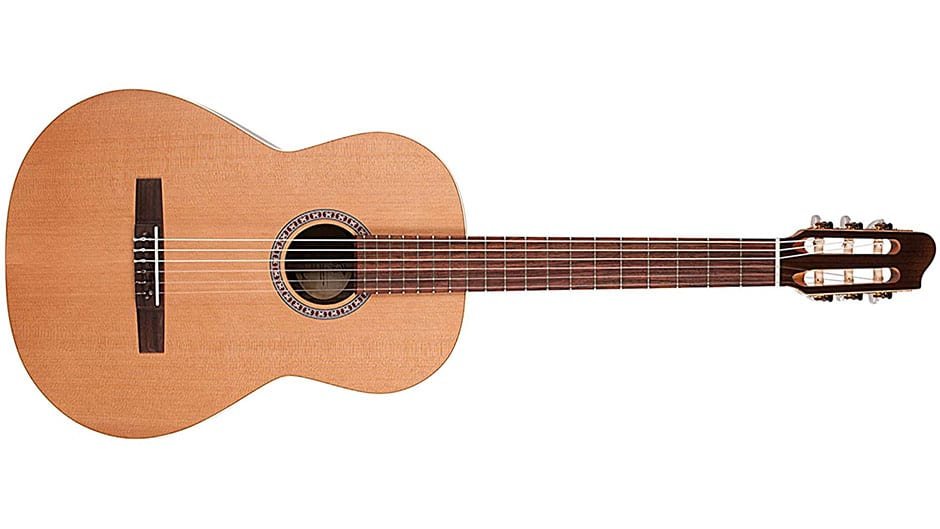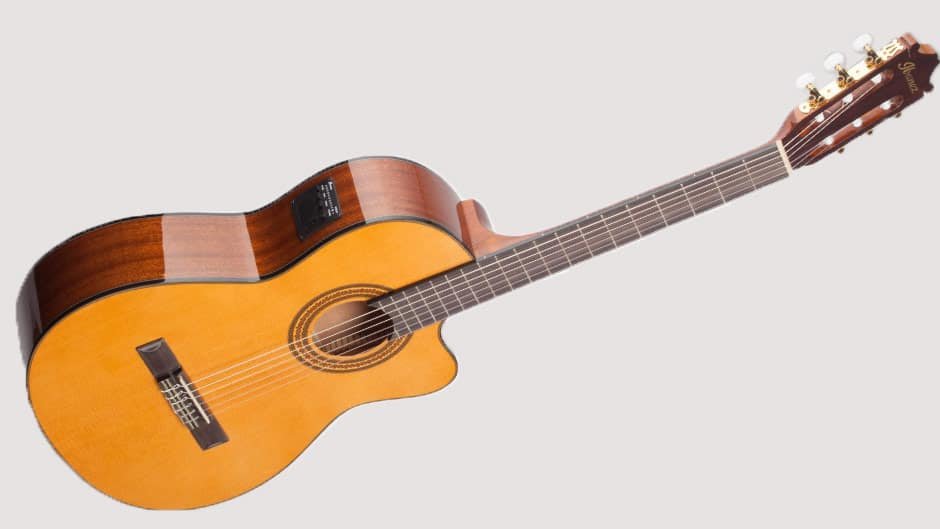Think about popular music and most people will think of a guitar. Very few people will think of a classical guitar, though.
What is the classical guitar and what is it used for? A classical guitar’s main differences with the regular acoustic guitar are: nylon strings (vs metal), wider neck for greater separation between strings (vs a narrow neck), a plucking technique using right hand fingers (vs a plectrum) and a quieter sound (vs loud). The fundamental difference, though, lies in the music the classical guitar is used for playing – classical music.
While it is true that many pop/rock/jazz artists do play and include a classical guitar in some of their compositions, the main reason for anyone to buy a classical guitar is to play the music of the old masters: Bach, Sor, Carcassi, Tarrega and the like.
The classical guitar is designed from the ground up to be a different instrument meant for a different purpose than the regular, free-style strumming acoustic guitar. This is good to bear in mind especially when we want to start off a child into the world of the guitar.
The question to ask: Which of the two worlds is the right one for my child?
Table of Contents
Classical guitars: Built for classical music
This is an instrument from ages ago. Over centuries, it was used to play various songs of the times and countries (especially Spain). The term ‘classical’ derives from this rich history of music that this guitar evolved out of.
It is also known as the Spanish guitar. A lot of contributions, musically and in design, were spearheaded by Spain. Although a modern classical guitar has become in many ways a much bigger and different version of its cat-gut string ancestors, the music is still considered classic.
Different periods in the last 500 years or so have seen major composers with their unique composing styles. So studying the classical guitar is a serious study of the past masters like Fernando Sor, Matteo Carcassi, Mauro Giuliani, Francis Tarrega, Federico Moreno Torroba among numerous others.
Great composers like Bach, Mozart and Paganini have had their works transcribed for the classical guitar in later times.
There are talented and well respected composers today for the classical guitar like Andrew York and Leo Brouwer who are constantly breaking new ground.
It is a dazzling world of musical colors all it own. A classical guitar student, early on, learns to read music. His or her methods are serious and organized. Education takes place over years.
A child with musical talent will do well to take up the formal study of the classical guitar. He or she can always branch out into popular music (with a strong theoretical background on music) at any stage later. Or they can work towards the concert hall.
They can start with getting to know the famous songs ever for the classical guitar by checking out our review of 15 all-time greatest hit songs of the classical guitar. To learn more about where to learn the classical guitar online, here is my review of top five online courses for learning the classical guitar.
If you’re thinking about a good, affordable classical guitar for a novice player, I highly recommend looking into my review of classical guitar options for beginners.
Perhaps a good place to start is by listening to some classical guitar music. I have listed out our top selections in classical guitar albums many of which can be streamed. Do check it out if you’re interested.
Classical guitars: Built different, look different, perform different

Nylon strings: The easiest to spot and hear are the nylon strings. Compared with the loud metal strings of an acoustic guitar, nylon has a mellow, soft sound. It is considered perfect for rendering classical music. For a child starting out, even someone as young as 5 years, nylon does not ‘cut’ into the fingers like metal does. It is thus a gentler introduction to the world of the guitar in general.
Neck size: This refers to the width of the neck (where left hand fingers stop the strings) as well as the front-to-back thickness of it. The classical has a wider neck (about 50 mm at the nut) to increase the distance between strings for easier playing and is also thicker front to back. Acoustics have narrower necks of around 42 mm at the nut.
Strings at the bridge: In a classical guitar, the strings are tied through holes in the bridge for a typical ‘classical’ look. Acoustic guitars have an easier mechanism with bridge pins inserted to hold the strings in place. String changing is a different process between the guitars.
String tension: The strings of the classical guitar relatively are under less tension than metal strings of an acoustic. It is one of the reasons (the high tension) that an acoustic guitar tends to be louder. Classical guitars also use fan bracing (placing of wooden struts under the top wood) while acoustics use X bracing.
Fingerboard shape: You can tell a classical guitar straight away from its flat fingerboard. Acoustics have a convex curve shape in their fingerboards. This is why you can’t use a capo meant for one type of guitar on the other!
Classical guitars: Built for a different technique
As is to be expected of a formal instrument, the techniques are also fairly complex and standardized. Both the right and left hand movements (and their co-ordination) are pretty much codified after decades of experimentation.
For instance, the right hand fingers do not use a pick or a plectrum. Only the thumb and the index, middle and ring fingers pluck the strings, using patterns of strict alternation. Training in the beginning years concentrates on bringing a fair degree of control over right hand fingers.
The left thumb does not peek over the neck of the fingerboard – a sight so common among acoustic (and electric) guitar players. It has to do with the thicker neck of the classical guitar, as also with the basic approach to technique.
Such studied fingering techniques as these are common in the world of the classical guitar. They are meant to be gone over thoughtfully and practiced diligently.
Of great technical importance is posture. A classical guitarist traditionally used to balance the curve of the guitar’s bout on their left knee, while placing the left leg on a footstool of about 6 to 8 inches high. This slanted the instrument’s fingerboard at an angle upward and was typical of classical guitar playing.
In recent times, in the last ten years or so, the footstool is being replaced by other support devices affixed to the guitar itself to achieve the customary height and angle without having to have one leg raised.
Today’s classical guitarists use one of these support devices while keeping both feet grounded on the floor for a well balanced look.
Classical guitars: Anything in common with acoustics?
Both are guitars, of course! Both the classical and the acoustic guitars have six strings that are tuned exactly the same way: E-A-D-G-B-E.
If you are reasonably good at playing one, you can find your way on the other without fuss. But there are limits. A musician who has only played the acoustic by using a plectrum primarily will not find much joy strumming a classical guitar.
Although today’s classical guitars have a good resonance and can respond well to strumming, it may not provide that enjoyable a result to most players. On the contrary, the reduced volume of the nylon strings and the stridency of the pick striking the nylons can lead to a lame sound.
Where the classical guitar springs to life for the acoustic player is when they are already good at finger picking. The classical guitar, as seen earlier, was born to be plucked. A finger picking guitarist will find hours of joy hidden inside the classical instrument.
It’s the reason why even leading pop/rock artists occasionally play and include the classical guitar in their pop or rock compositions.
To increase the volume and reach of the soft classical guitar, many popular musicians prefer a hybrid cutaway classical guitar with a pre-amp built in!

The Ibanez GA6CE is one such instrument with a cutaway to allow access to the higher frets, yet it is a ‘proper’ classical guitar built to standard classical conventions in terms of dimensions, choice of woods, etc.
I have a detailed review of the Ibanez GA6CE guitar if you’re interested. If you want to know more about classical guitar technique check out our article: Is the classical guitar harder to play?
The actual physical instrument comes in a bewildering array of sizes and if you’re not sure, check out my article Classical Guitar Sizes Guide.
Happy strumming, no… plucking!
